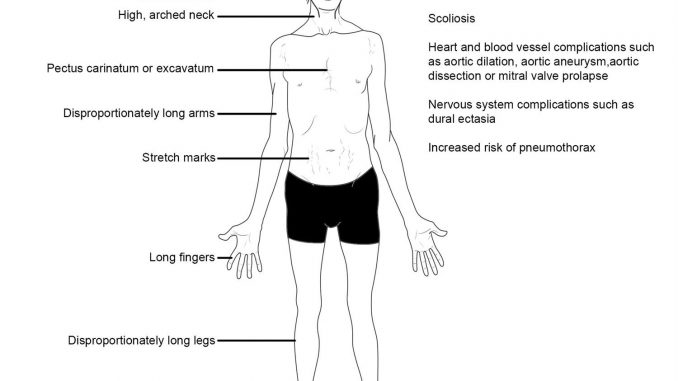
Marfan syndrome:
- Marfan syndrome is one of the genetic disorders i.e. the child inherits from their parents.
- It is a condition that affects the connective tissue of body.
- Connective tissue functions as a means to provide support, strength, and elasticity to various vital parts of body as tendons, heart valves, blood vessels, cartilage and eyes.
- Connective tissue also accounts for proper growth and development of body.
- Marfan syndrome is termed after Antoine Marfan. He was a pediatrician who first explained the condition in 1896.
- Men and women of all races and ethnic groups can have this syndrome. About 1 in 5000 people have this condition.
- Marfan syndrome is an autosomal dominant gene mutation. It occurs equally in both men and women and can be inherited from single parent having Marfan syndrome.
- The probability that the child will inherit this condition is ½ i.e. 50%
Genetics behind Marfan syndrome
- Marfan syndrome is caused by the alteration/mutation in the fibrillin1(FBN1) gene located at position 21.1 on the long arm of chromosome no. 15
- Fibrillin1(FBN1) gene encodes fibrillin1 protein. This large protein forms microfibrils in matrix and the microfibrils form elastic fibers that provides elasticity to the ligaments, skin and blood vessels.
- Fibrillin1 also enhances the activity of TGF-b (Transforming growth factor b) that regulates cells how to behave (growth) i.e., microfibrils also regulate the growth and repair the tissues and organs in the body.
- Mutation on FBN1 gene in Marfan syndrome halts the production of fibrillin1 protein and leads to elevated levels of cytokines.
Symptoms of Marfan syndrome:
Marfan syndrome results in ocular, musculoskeletal, cardiac and pulmonary deformities.
- Musculoskeletal disorder: The symptoms include-
- Abnormal increase in height
- Unusual curved spine termed as scoliosis
- Sternum protrudes out or caves inward.
- Large flat feet and hammer toes
- An arch in the roof of mouth causing crowded teeth
- Long unequal arms and fingers
- Pain felt in joints, bones and muscles
- Over flexibility of bones
- Dural ectasia
- Spondylolisthesis
- Stretch marks seen in shoulders, lower back and hips
- High palates resulting speech disorder
- Hypotonia (Muscle tone lagging)
- Ocular disorder: the symptoms include-
- Shortsightedness
- Dislocated lens
- Detachment of retina
- Blurred vision
- Glaucoma (Increased pressure in eyeball)
- Cataracts
- Cardiac disorder: the symptoms include-
- Weak walls of aorta
- Aortic aneurism (swelling or enlargement of aorta)
- Dysfunction of mitral or tricuspid valves causes leakage of blood through back of valve.
- Arrhythmia
- Cardiomyopathy
- Pulmonary disorder: the symptoms include-
- Bronchitis
- Risk of asthma
- Pneumonia
Diagnosis:
- The diagnosis takes place by going through the family history and physical examination.
- Genetic testing:
- -t is performed to check the mutations of Marfan syndrome.
- It is quite expensive and takes almost 3 months for completion.
- Prenatal testing:
- This test is done in babies from parents with Marfan syndrome.
- Either chorionic villus sampling or amniocentesis can be done.
- Chorionic villus sampling (CVS):
- It is done after 10-12 weeks of pregnancy.
- CVS is performed by taking small samples of cells from placenta.
- The sample is then further tested for genetic conditions.
- Amniocentesis:
- This test is performed about 16-18 weeks of pregnancy.
- It is carried out by taking out small sample of amniotic fluid for examination.
- Other testing:
- Eye examination: Ophthalmologists check for the dislocation of lens.
- An echocardiogram for allowing the doctors to check for heart problems and aorta.
- CT scan or MRI scan (produces detailed image of internal structure) to check the aorta and blood vessels to detect dural ectasia.
Treatment:
- The treatment for the marfan syndrome varies from person to person according to severity of the symptoms. There is no complete cure for this syndrome till date.
- Some need to regularly visit doctors for follow up and others require medications and surgery.
- Medications are not typically prescribed in case of Marfan syndrome. However, beta blockers are prescribed in order to prevent heart damage. Beta blocker enhances the relaxation of heart, maintains pressure within arteries and reduces forcefulness of heartbeat.
- Verapamil is recommended for people having side-effects with beta blockers. Verapamil is a calcium channel blocker.
- Angiotensin receptor blocker (ARB) is a type of medication having a role in chemical pathway in body. It is used for treatment of heart failure or high blood pressure.
- Physiotherapy is recommended for the skeletal problems and muscle strengthening.
- Surgery:
- Patients with leaked valve issues undergo valve replacement or repair surgeries.Heart surgery is done in people with Marfan syndrome in which a section of an enlarged aorta is replaced.
- This operation is performed only if aorta measures between 4.5cm to 4.8cm.
- If people with Marfan syndrome develop cataracts then cataract surgery is recommended.
- Laser treatment or surgery is advised for people with glaucoma.
- Bracing and surgery is needed in some cases of scoliosis.
- Surgeries are done for the breastbone correction.
- Re-occurring pneumothoraxes may require chest surgery.
- Individuals with Marfan syndrome should avoid extreme sports, heavy-lifting and exercises that causes tearing of aorta.
- Pregnant ladies with Marfan syndrome should perform prenatal testing to confirm if it has been inherited. Preimplantation genetic testing is also performed for the rejection of embryos with Marfan syndrome.
References:
- https://rarediseases.org/rare-diseases/marfan-syndrome/
- https://my.clevelandclinic.org/health/diseases/17209-marfan-syndrome/management-and-treatment
- https://www.nhs.uk/conditions/marfan-syndrome/treatment/
- https://www.medicalnewstoday.com/articles/179900#outlook
- https://www.healthline.com/health/marfan-syndrome#prevention
- https://www.marfan.org/about/marfan
- https://ghr.nlm.nih.gov/condition/marfan-syndrome#diagnosis
- https://www.mayoclinic.org/diseases-conditions/marfan-syndrome/diagnosis-treatment/drc-20350787
- https://www.webmd.com/heart-disease/guide/marfan-syndrome#4
